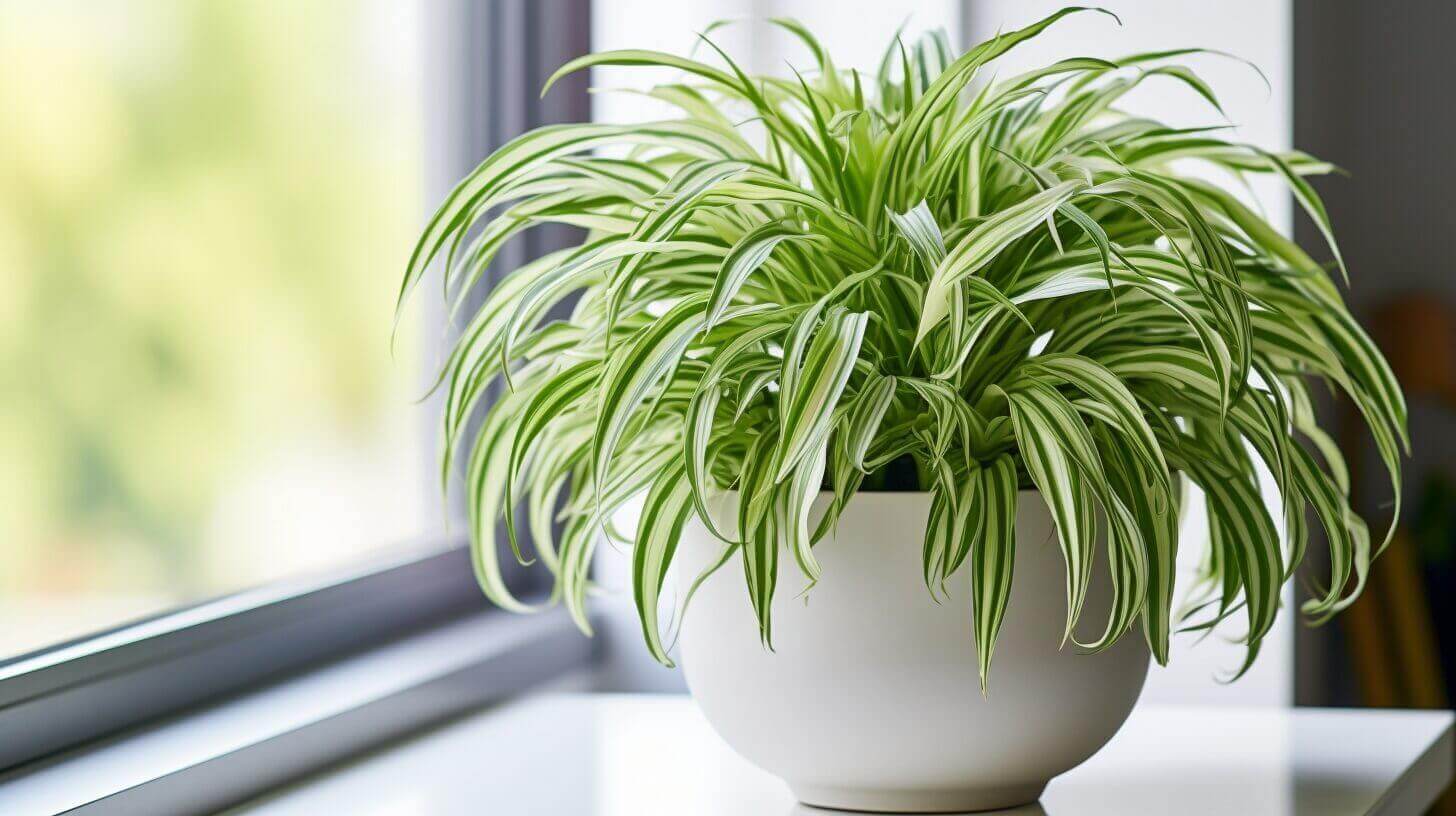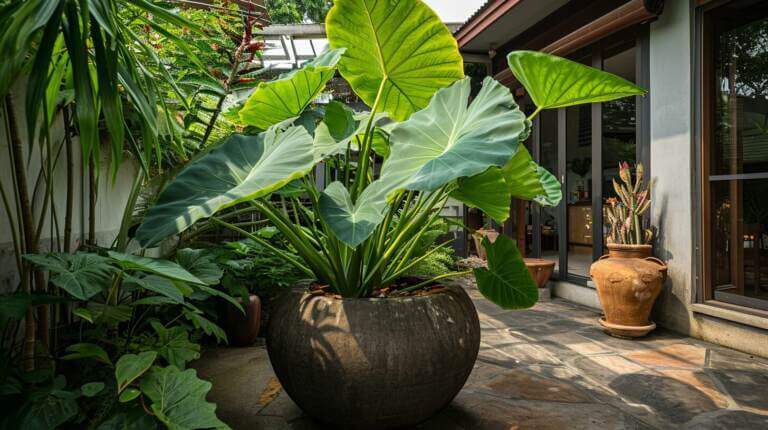Are you tired of your spider plant looking sparse and lacking fullness? Look no further! In this article, we will provide you with five useful tips to make your spider plant bushier than ever before.
From choosing the right pot size to pruning and propagating, we will guide you through the process step by step.
By implementing these techniques, you’ll be able to achieve a lush and thriving spider plant that will bring joy to any space.
Key Takeaways
- Pot size greatly influences the growth of spider plants.
- Spider plants thrive in bright, indirect light and should be placed near a north or east-facing window for indoor plants.
- Consistent watering routine is essential for healthy growth, avoiding overwatering to prevent root rot and yellowing leaves.
- Pruning and propagation techniques, such as removing dead leaves and propagating through division or planting plantlets, promote fuller growth in spider plants.
Choose the Right Pot Size
Selecting the appropriate pot size is crucial for promoting optimal growth and development in your spider plant. Choosing the right pot size can greatly influence the growth of your spider plant. When selecting the ideal container, there are several factors to consider.
First, ensure that the pot has drainage holes to prevent water from accumulating and causing root rot. Additionally, choose a pot that is slightly larger than the current root ball of the spider plant, allowing room for growth. This will prevent the roots from becoming cramped and promote healthier growth. Another consideration is the material of the pot. Clay or terracotta pots allow for better airflow and drainage, while plastic pots retain moisture for longer periods.
In terms of repotting techniques, it is important to know how to properly repot your spider plant to encourage bushier growth. When repotting, gently remove the plant from its current container, being careful not to damage the roots. Loosen the roots and remove any dead or damaged ones. Place the plant in the new pot, ensuring that it is centered and at the same depth as before. Fill the pot with fresh, well-draining potting mix, pressing it gently around the roots. Finally, water the plant thoroughly to settle the soil and promote root establishment.
Choosing the right pot size and utilizing proper repotting techniques are essential in promoting bushier growth in your spider plant. However, it is equally important to provide adequate sunlight for its overall development.
Provide Adequate Sunlight
To ensure optimal growth and health, it is important to provide your spider plant with ample amounts of sunlight both indoors and outdoors. Spider plants thrive in bright, indirect light, making them perfect for areas that receive partial shade.
Here are three essential tips to create the ideal lighting conditions for your spider plant:
Sunlight requirements for indoor plants:
- Place your spider plant near a north or east-facing window to provide it with bright, indirect light.
- Avoid placing it in direct sunlight, as this can scorch the leaves.
How to create the ideal lighting conditions:
- If your spider plant is kept indoors, rotate it once a week to ensure all sides receive equal light exposure.
- If you don’t have access to natural light, use artificial grow lights to supplement the plant’s lighting needs.
Transition to the next section about watering:
- Along with adequate sunlight, proper watering is crucial for the health and growth of your spider plant.
Water Properly and in Moderation
Implementing a consistent watering routine is essential for promoting healthy and lush growth in your spider plant. Spider plants prefer to be kept evenly moist but not overly wet. One effective watering technique is to water the plant thoroughly, allowing the water to drain completely from the pot. This helps to prevent the roots from sitting in water, which can lead to rot and other problems.
It’s important to avoid overwatering, as this can cause root rot and yellowing leaves. An easy way to check if your spider plant needs water is to stick your finger about an inch into the soil. If it feels dry, then it’s time to water.
Transitioning into the next section, using a well-draining soil mix is another key factor in maintaining the proper moisture levels for your spider plant.
Use a Well-Draining Soil Mix
To ensure optimal growth and prevent waterlogged roots, it is important to use a well-draining soil mix for your spider plant. This type of soil allows excess water to drain out quickly, preventing the roots from becoming waterlogged and susceptible to root rot.
Here are three tips for using a well-draining soil mix for your spider plant:
- Choose the right fertilizer: Spider plants prefer a balanced fertilizer with equal amounts of nitrogen, phosphorus, and potassium. Look for a slow-release fertilizer specifically formulated for houseplants.
- Adjusting pH levels: Spider plants thrive in slightly acidic to neutral soil pH levels ranging from 6.0 to 7.0. Test the pH of your soil and adjust it accordingly using organic soil amendments like peat moss or compost.
- Consider adding perlite or coarse sand: Adding perlite or coarse sand to your soil mix can improve drainage and aeration, ensuring that excess water doesn’t accumulate around the roots.
Prune and Propagate for Fuller Growth
After establishing a well-draining soil mix for your spider plant, it is important to prune and propagate regularly to promote fuller growth. Pruning helps remove dead or damaged leaves, encourages new growth, and helps maintain the overall shape of the plant.
To prune your spider plant, simply use clean, sharp scissors or pruning shears to cut back any unwanted or overgrown foliage. Be sure to make clean cuts just above a node or joint to encourage new growth.
Additionally, propagating your spider plant can help it become bushier. Spider plants can be easily propagated through division or by planting the plantlets that grow on the ends of long stems.
Frequently Asked Questions
How Often Should I Fertilize My Spider Plant to Promote Bushier Growth?
To promote bushier growth in your spider plant, it is important to fertilize it regularly. The frequency of fertilizing depends on the type of fertilizer you are using. Generally, spider plants benefit from being fertilized every 2-4 weeks during the growing season. However, it is important to follow the instructions on the fertilizer packaging for specific guidelines.
Additionally, ensure that you are using a balanced fertilizer and that you are also providing adequate watering to support the plant’s overall health.
Can I Use Tap Water to Water My Spider Plant, or Should I Use Filtered or Distilled Water?
When it comes to watering your spider plant, the choice between tap water and filtered/distilled water can make a difference in its overall growth.
While tap water is generally safe to use, it may contain minerals and chemicals that can accumulate in the soil over time and affect the plant’s health.
Filtered or distilled water, on the other hand, removes impurities and provides a cleaner source of hydration for your spider plant, promoting better growth and preventing potential issues.
What Are Some Common Signs of Overwatering or Underwatering a Spider Plant?
Signs of overwatering or underwatering a spider plant can include:
- Yellowing or wilting leaves
- Root rot
- Stunted growth
Overwatering can lead to:
- Fungal infections
- Mold growth
Underwatering can cause:
- Dry and brittle leaves
To properly water a spider plant without over or under watering it, it is important to:
- Check the soil moisture level before watering
- Ensure that the plant is placed in well-draining soil
Regularly monitoring and adjusting the watering schedule based on the plant’s needs is crucial for maintaining its health and promoting optimal growth.
What Are Some Tips for Making Spider Plants Grow Fuller and Faster?
When it comes to growing spider plants, there are a few tips you can follow to help them grow fuller and faster. Firstly, ensure they have well-draining soil and receive bright, indirect sunlight. Regularly water the plants, allowing the soil to dry out between waterings. Consider using diluted liquid fertilizer every two weeks during the growing season. Additionally, propagating spider plant babies can encourage fuller growth.
Can I Use a Regular Potting Soil Mix for My Spider Plant, or Do I Need to Use a Special Mix?
Using a regular potting soil mix for your spider plant is generally sufficient, as spider plants are not overly picky about their soil. However, using a special mix designed specifically for spider plants can provide additional benefits, such as enhanced drainage and nutrient availability.
It is important to ensure that the soil is well-draining and not overly compacted. Additionally, using filtered or distilled water can be beneficial for spider plants, as it helps to avoid the build-up of minerals or chemicals that may be present in tap water.
How Long Does It Typically Take for a Spider Plant to Show Signs of Fuller Growth After Pruning and Propagating?
The propagation timeline and the time it takes for a spider plant to show signs of fuller growth after pruning can vary depending on various factors such as environmental conditions, care, and the health of the plant.
It is generally recommended to allow at least a few weeks for the plant to recover and start growing new foliage after pruning.
Regular pruning techniques, such as removing dead leaves and trimming leggy stems, can promote bushier growth and encourage the plant to produce more offshoots.







